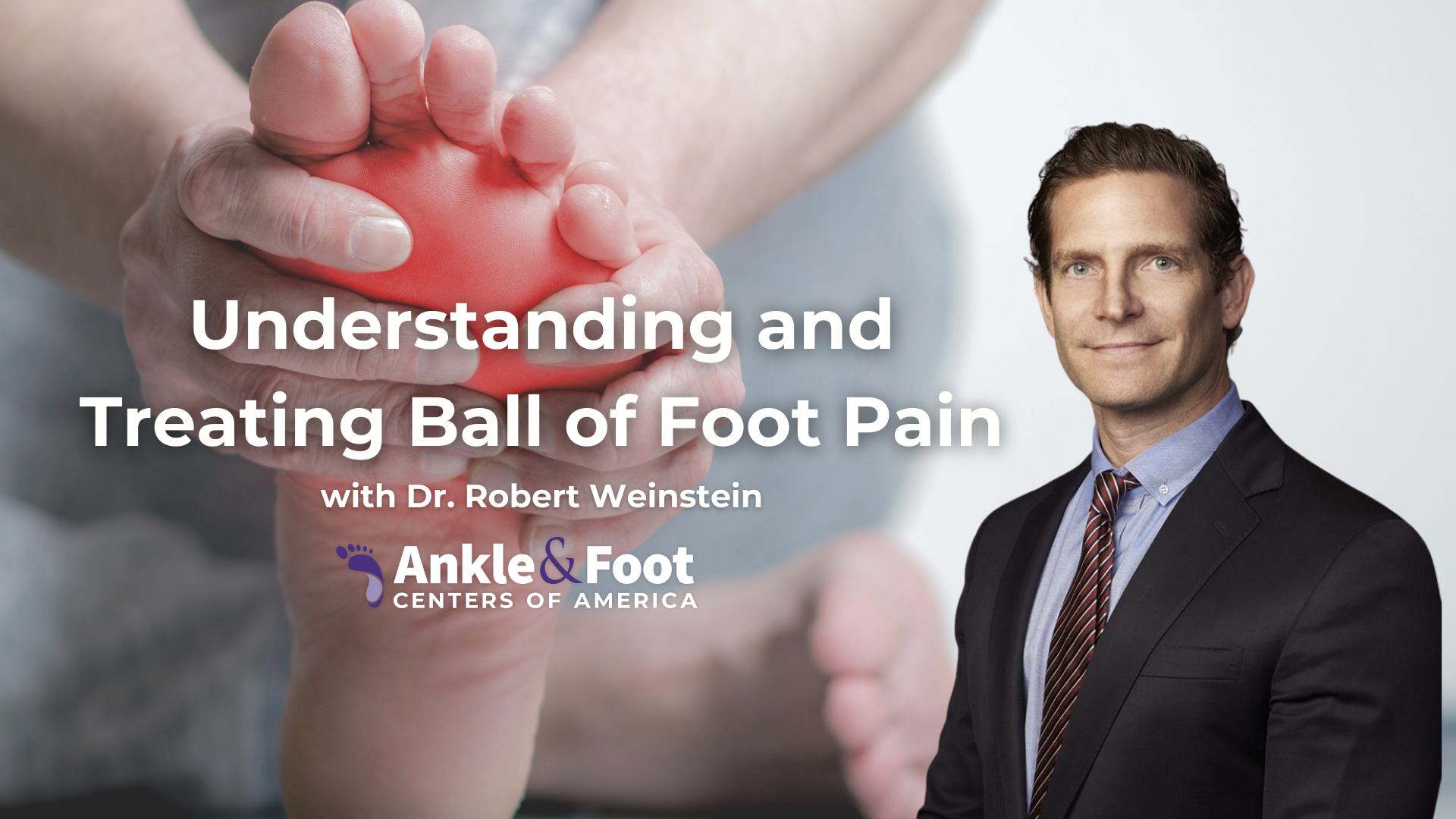Ball of foot pain can be a hindrance in daily life, affecting mobility and comfort. Understanding its causes, symptoms, and treatment options can empower individuals to manage and alleviate their pain effectively. This blog post will explore various aspects of ball of foot pain, providing valuable insights to help you take control of your foot health.
Table of Contents
Short Summary
- Identifying ball of foot pain involves recognizing the location, type and underlying causes.
- Common symptoms include sharp, aching, burning pain, numbness, tingling. And increased pain with activity.
- Preventive measures such as wearing appropriate shoes and consulting healthcare professionals can reduce the risk of developing ball of foot pain.
Identifying Ball of Foot Pain
Ball of foot pain, also known as metatarsalgia, is a common condition characterized by:
- Pain and inflammation in the forefoot area
- The pain typically occurs on the bottom of the foot, just behind the toes
- The pain can range from a dull ache to a sharp, burning sensation.
While anyone can experience metatarsalgia, certain factors such as foot deformities, injuries, and high-impact activities can increase the likelihood of developing it. Recognizing ball of foot pain involves identifying the location and type of pain, as well as any contributing factors.
Common Symptoms
Symptoms of ball of foot pain include:
- Sharp, aching, or burning pain
- Numbness
- Tingling
- Increased pain with activity
The pain associated with metatarsalgia, also known as metatarsal pain, fluctuates in intensity in response to changes in activity. In some cases, the forefoot may become red or swollen due to the pressure and weight distribution in the affected area.
Understanding these common symptoms can help you identify ball of foot pain and seek appropriate treatment.
How to Recognize Ball of Foot Pain
Recognizing ball of foot pain involves identifying the location and type of pain, as well as any contributing factors such as:
- high activity levels
- prominent metatarsal heads
- weak toe flexor muscles
- tight toe muscles
- a tight Achilles tendon
- improper footwear
- excessive pronation
It is important to pay attention to the severity and duration of the pain, as well as any accompanying symptoms such as redness, swelling, or numbness.
If you suspect you have ball of foot pain, it is essential to consult a healthcare professional, such as a podiatrist, to evaluate the symptoms and perform a physical examination.

Causes Behind Ball of Foot Pain
Several causes can contribute to ball of foot pain, including foot deformities, excess weight, and high-impact activities. Understanding these factors can help you identify potential triggers for your pain and take appropriate preventive measures. For instance, wearing the right shoes, maintaining a healthy weight, and avoiding certain activities can help minimize the risk of developing ball of foot pain.
Taking preventive measures can help reduce the risk of ball of foot pain. This includes wearing shoes.
Foot Deformities and Injuries
Foot deformities and injuries can lead to localized pressure and inflammation in the forefoot, causing ball of foot pain. Conditions such as:
- having a high arch
- a hammertoe deformity
- a short first metatarsal bone
- a long second metatarsal bone
May be associated with ball of foot pain, including shooting pain.
Injuries to the feet, particularly those sustained during high-impact activities, can also contribute to the development of ball of foot pain. One common cause of this discomfort is a foot injury.
Excess Weight and Pressure
Excess weight and pressure on the forefoot can cause pain and inflammation. Activities such as running, jumping, and walking can increase the pressure on the bones, joints, and soft tissues in the ball of the foot, leading to pain.
Reducing excess weight and pressure through proper footwear, arch supports, and shock-absorbing insoles can help alleviate ball of foot pain.
High-Impact Activities
 High-impact activities, such as running and jumping, can contribute to ball of foot pain by putting additional stress on the forefoot. To minimize the risk of developing ball of foot pain, it is essential to incorporate rest days into your weekly routine and use appropriate footwear with adequate support and cushioning.
High-impact activities, such as running and jumping, can contribute to ball of foot pain by putting additional stress on the forefoot. To minimize the risk of developing ball of foot pain, it is essential to incorporate rest days into your weekly routine and use appropriate footwear with adequate support and cushioning.
Regular foot care and stretching exercises can also help prevent overuse injuries, such as stress fractures, related to high-impact activities.
The Impact of Footwear on Ball of Foot Pain
Footwear plays a significant role in the development and management of ball of foot pain. Wearing shoes that are not properly fitted can result in excessive pressure on the ball of the foot, causing pain and discomfort. Conversely, shoes with good arch support and cushioning can help alleviate pain and prevent further issues.
Let’s delve deeper into how different elements of footwear can impact ball of foot pain.
High Heels and Extra Pressure
High heels can cause extra pressure on the forefoot, leading to pain and discomfort. Wearing high heels forces the body weight to shift towards the ball of the foot, increasing the pressure on the metatarsal bones and joints.
To reduce the pressure associated with wearing high heels, it is recommended to wear shoes with a lower heel, arch supports, and shock-absorbing insoles.
Importance of Proper Shoe Fit
Proper shoe fit is essential for preventing and managing ball of foot pain. Shoes that are too tight can generate excessive pressure on the ball of the foot, whereas shoes that are too loose can cause the foot to slide forward and increase stress on the toes.
Ensuring that your shoes fit correctly and provide adequate support can help alleviate ball of foot pain and reduce the risk of developing related conditions.
Arch Support and Shock Absorbing Insoles
Arch support and shock-absorbing insoles can help decrease the pressure on the ball of the foot, thus alleviating pain and discomfort. They can also improve the overall fit of the shoe, thereby enhancing support and stability.
Incorporating arch supports and shock-absorbing insoles into your footwear can help manage ball of foot pain and promote overall foot health.
Managing and Relieving Ball of Foot Pain
Managing and relieving ball of foot pain involves using metatarsal pads, orthotic inserts, and practicing proper foot care. These measures can provide relief from pain and pressure, redistribute weight on the foot, and prevent further issues.
Let’s explore these strategies in more detail.
Metatarsal Pads and Arch Supports
Metatarsal pads and arch supports can provide relief from pain and pressure in the ball of the foot by redistributing weight and cushioning the metatarsal bones. They can be especially helpful for individuals with foot deformities, such as high arches or hammertoes, that may contribute to ball of foot pain.
Incorporating metatarsal pads and arch supports into your footwear can help alleviate pain and improve overall foot comfort.
Orthotic Inserts and Cushioning
 Orthotic inserts and cushioning can help redistribute pressure and alleviate pain in the ball of the foot. These devices can be custom-made or purchased over-the-counter and provide additional support and cushioning for various foot conditions.
Orthotic inserts and cushioning can help redistribute pressure and alleviate pain in the ball of the foot. These devices can be custom-made or purchased over-the-counter and provide additional support and cushioning for various foot conditions.
Using orthotic inserts and cushioning in your footwear can help manage ball of foot pain and promote overall foot health.
Foot Care Routines and Exercises
Foot care routines and exercises can help strengthen and stretch the foot muscles, reducing pain and improving overall foot health. Incorporating targeted stretches and strengthening exercises into your daily routine can not only alleviate pain but also prevent future issues related to ball of foot pain.
Proper foot care, including regular foot inspections and maintaining good hygiene, can also help manage pain and prevent complications.
Conditions Related to Ball of Foot Pain
Several conditions are related to ball of foot pain, including Morton’s neuroma, bunions, and hammertoes. These conditions can cause localized pain and discomfort in the ball of the foot and may require specific treatment approaches.
Understanding the connection between these conditions and ball of foot pain can help you manage your symptoms more effectively.
Morton’s Neuroma
Morton’s neuroma is a painful condition caused by thickening of the tissue around a nerve in the ball of the foot. This thickening can result in pain, burning, and tingling sensations in the ball of the foot and toes.
Treatment for Morton’s neuroma typically includes rest, ice, and over-the-counter painkillers, while more severe cases may require corticosteroid injections or surgery.
Bunions
Bunions are bony bumps that form at the base of the big toe, causing pain and discomfort. They can be caused by:
- wearing tight, narrow shoes that squeeze the toes together
- foot injuries
- arthritis
- an inherited foot structure.
Treatment for bunions may include wearing wider shoes, using bunion pads or orthotics, and taking anti-inflammatory medications. In more advanced cases, surgery may be necessary to correct the deformity.
Hammertoes
Hammertoes are deformities that cause the toes to bend downward at the middle joint, giving them a hammer-like appearance. These deformities usually affect the second toe, third, or fourth toe, and can cause pain and pressure in the ball of the foot, as the toe bones are forced into an unnatural position.
Treatment options for hammertoes include:
- Wearing appropriate footwear
- Utilizing orthotic devices
- Exercising to strengthen the toe muscles
- In more severe cases, surgery may be necessary to correct the deformity.

Seeking Medical Help for Ball of Foot Pain
Knowing when to seek medical help and understanding diagnostic tests can help ensure proper treatment for ball of foot pain. It is important to consult a healthcare professional if your pain persists for more than a few days or if you are experiencing swelling and discoloration.
A medical professional can evaluate your symptoms, perform necessary tests, and recommend appropriate treatment options.
When to See a Doctor
Seek medical attention if:
- Pain persists for more than two weeks
- Severe pain is accompanied by swelling and discoloration
- The pain is impeding your daily activities or causing sleep deprivation
- You have other health issues such as arthritis or diabetes that may be connected to the foot pain.
These conditions should be taken seriously, as they can be indicative of a more serious underlying issue.
Diagnostic Tests and Procedures
Diagnostic tests that may be used to assess ball of foot pain include:
- Foot examinations
- X-rays
- Bone scans
- Ultrasounds
- MRIs
These tests can help determine the cause of your pain and ensure proper treatment.
In some cases, a physical examination by a healthcare professional may also be necessary to evaluate the symptoms and identify the source of the pain.
Treatment Options for Ball of Foot Pain
 Treatment options for ball of foot pain range from conservative treatments to surgical interventions. Conservative treatments, such as rest, ice, and proper footwear, can provide relief from pain and pressure.
Treatment options for ball of foot pain range from conservative treatments to surgical interventions. Conservative treatments, such as rest, ice, and proper footwear, can provide relief from pain and pressure.
In more severe cases or when conservative treatments are ineffective, surgical interventions may be necessary to address the underlying cause of the pain.
Conservative Treatments
Conservative treatments for ball of foot pain include:
- Rest
- Ice
- Anti-inflammatory medications
- Proper footwear
These measures can help relieve pain and pressure, redistribute weight on the foot, and prevent further issues as body weight transfers.
It is important to consult with a healthcare professional to determine the most appropriate conservative treatment options for your specific condition.
Surgical Interventions
Surgical interventions for ball of foot pain may be necessary in severe cases or when conservative treatments are ineffective. Some surgical options include:
- Neurectomy
- Metatarsal osteotomy
- Hammertoe repair
- Bunion surgery
Your healthcare professional can help determine if surgical intervention is necessary and recommend the most appropriate surgical option for your condition.
Final Thoughts
Understanding the causes, symptoms, and treatment options for ball of foot pain can help individuals manage and alleviate their pain effectively. By recognizing the signs of ball of foot pain and seeking appropriate medical help, you can ensure proper treatment and prevent further complications.
Implementing preventive measures, such as wearing proper footwear and practicing foot care routines, can also contribute to overall foot health and well-being.
In conclusion, ball of foot pain can be a bothersome and limiting condition, but with the right knowledge, you can take control of your foot health. By understanding the various causes, symptoms, and treatment options, as well as seeking medical help when necessary, you can manage and alleviate your pain effectively. Remember that prevention is key – proper footwear, foot care routines, and knowing when to rest can go a long way in maintaining your overall foot health.
Frequently Asked Questions
How do you relieve pain in the ball of your foot?
To relieve pain in the ball of your foot, use metatarsal pads, a surgical shoe, or a shoe insert, and make sure you pick shoes with good soles, wide toe box, and low heel. Additionally, rest and elevate your foot, apply an ice pack to the painful area, wear comfortable shoes, use soft insoles or pads, and if necessary, aim to lose weight.
Taking care of your feet is essential for reducing pain and discomfort. Make sure to wear shoes that fit properly and provide adequate support. Choose shoes with good soles, wide toe box, and low heel. Additionally, rest and elevate your foot, apply an ice pack to the painful area, and use soft tissue.
What does it mean when the ball of your foot is hurting?
Pain in the ball of the foot is often caused by exercise, poorly fitting shoes or conditions like arthritis. It can also be a result of increased pressure due to hard or cracked skin, a verruca or other overuse injuries, such as metatarsalgia.
Will ball of foot pain go away on its own?
Pain in the ball of your foot can sometimes go away on its own, but if it persists or worsens after a few days of rest and changing your footwear, you should consult a doctor.
To improve your condition and speed up recovery, it is important to maintain a moderate weight, wear comfortable shoes, and refrain from activities that aggravate the pain. With prompt management and compliance, complete recovery should take 6 to 8 weeks.
What are the common symptoms of ball of foot pain?
Common symptoms of ball of foot pain include sharp, aching or burning pain, numbness, tingling, and increased pain with activity.
How can I prevent ball of foot pain?
To prevent ball of foot pain, wear supportive shoes, stay within a healthy weight range, and avoid activities that put extra strain on the feet.
These activities may include running, jumping, or standing for long periods of time. Wearing shoes with good arch support and cushioning can help reduce the strain on the feet. Additionally, maintaining a healthy weight can help reduce the pressure.





